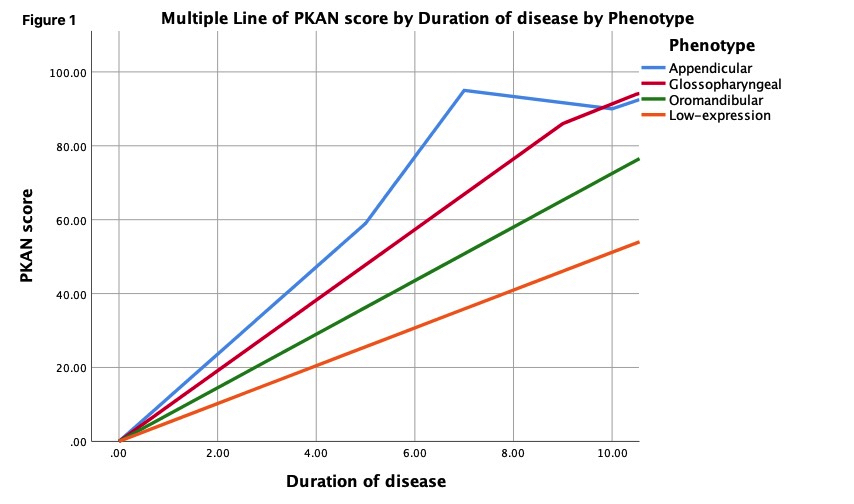Session Information
Date: Monday, September 23, 2019
Session Title: Rare Genetic and Metabolic Diseases
Session Time: 1:45pm-3:15pm
Location: Les Muses Terrace, Level 3
Objective: Analysis of a large genetically homogenous PKAN population, assessing demographics, clinical features, and rating scales to characterize observed phenotypic heterogeneity.
Background: PKAN is an autosomal recessive disorder linked to >50 different mutations in the PANK2 gene, worldwide incidence of 1-3 /million, and childhood onset. Features include dystonia, speech difficulties, spasticity, rigidity, and choreoathetosis. Classically, patients divide into early onset “typical” (<6 yrs) with rapid progression and a later onset “atypical” that progress slowly. Because of its rarity, PKAN research has been limited to small cohorts with various mutations. A genetically homogenous PKAN cohort (70 patients, c.680 A>G mutation) exists in the Dominican Republic with prevalence 1,000 times higher than normal; 1-2 pts/1000, and a carrier rate of 15%.1
Method: Patients in the Dominican PKAN cohort were assessed between 2007-19. Data obtained included demographic, clinical, MRI, mortality, genetic, and videotaped rating scales. Means and standard deviations were calculated for a descriptive analysis of clinical and demographic features. Potential associations were tested with chi-square and correlation analysis.
Results: Seventy patients (40 F/30 M) had mean age of onset 9.5 ± 2.72 and disease duration 19.8 ±4.03 yrs. Later onset was associated with greater age (p= 0.034). 14% of patients died during the study period at a mean age 24.9 ± 3.82 yrs.60 of 70 patients were alive in 2019 with mean scores on Fahn-Marsden 92.2 ±14.2, UDRS 69.4 ± 26.1, PKAN scale 80.2 ± 21.7 and UPDRS (III) 71.8 ±17.9. Clinical features revealed 4 distinct phenotypes: oromandibular (OMD), glossopharyngeal (GP), appendicular (AP), and low expression (LO). OMD patients had marked swallowing difficulties but retained ambulation. The GP phenotype had prominent tongue protrusion with potential airway compromise. AP had distal involvement with the greatest disability due to loss of ambulation and hand function, whereas the LO group had the least disability and oldest age.Preliminary analysis suggests differences in progression rates, severity, and survival between phenotypes, specially within the first 10 years. (fig1)
Conclusion: Analysis of the Dominican PKAN cohort suggests heterogeneous expression within the c.680 A>G mutation with potentially useful prognostic implications; mortality was 14% and later onset was significantly associated with greater age.
References: 1. Delgado RF, Sanchez PR, Speckter H, Then EP, Jimenez R, Oviedo J, et al. Missense PANK2 mutation without “eye of the tiger” sign: MR findings in a large group of patients with pantothenate kinase-associated neurodegeneration (PKAN). J Magn Reson Imaging. 2012;35(4):788–794.
To cite this abstract in AMA style:
S. Baser, C. Muniz, F. Middleton, R. Ericson, M. Santana Jimenez, C. Bass. Distinct phenotypic expression in a large PKAN cohort in the Dominican Republic [abstract]. Mov Disord. 2019; 34 (suppl 2). https://www.mdsabstracts.org/abstract/distinct-phenotypic-expression-in-a-large-pkan-cohort-in-the-dominican-republic/. Accessed December 28, 2025.« Back to 2019 International Congress
MDS Abstracts - https://www.mdsabstracts.org/abstract/distinct-phenotypic-expression-in-a-large-pkan-cohort-in-the-dominican-republic/

